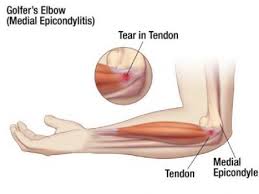An overuse injury of the medial epicondylitis of the elbow involving the epicondyle of the humerus, the wrist and finger flexor muscles, and the pronator muscles.
 Medial Epicondylitis: Initial Diagnosis and Management
Medial Epicondylitis: Initial Diagnosis and Management
- History of sudden overload to contractile units of the medial elbow.
- Physical examination for medial epicondylitis .
- Tenderness over medial epicondylitis of humerus.
- Pain with flexion of wrist or fingers.
- Pain with resistance to flexion of wrist or fingers.
- Loss of function or palpable gap in muscle due to medial epicondylitis.
- History of chronic use of wrist flexors or pronators.
Medial Epicondylitis: Ongoing Management and Objectives
- Flexibility exercises for wrist and finger flexor muscles and pronator muscles
- Strengthening exercises for wrist and finger flexor muscles and pronator muscles.
- Physical therapy procedures
- Proper conditioning
Medial Epicondylitis: Indication a profile is needed
- Any limitations that affect strength, range of motion, and general efficiency of upper arms.
- Slightly limited mobility of joints, muscular weakness, or other musculo-skeletal defects that may prevent hand-to-hand fighting and disqualifies for prolonged effort.
- Defects or impairments that require significant restriction of use
Medial Epicondylitis: Specifications for the profile
- Week 1-4
- No pushups or pull-ups or weight lifting with upper body
- Limited lifting
- Limit duties requiring repeated supination/pronation at forearm
- Caution with activities requiring wrist and hand grip use e.g. driving
